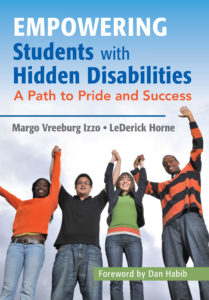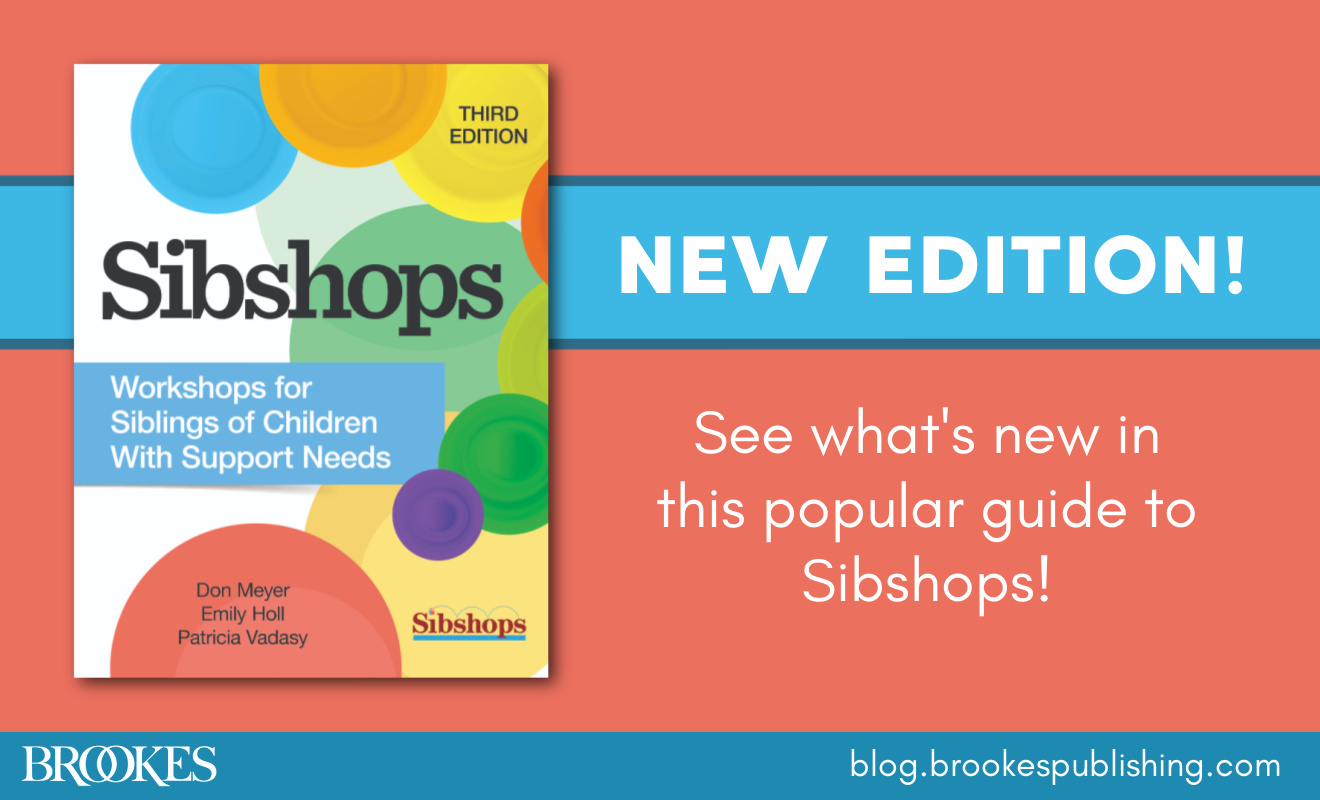Supporting Students on the Path to Disability Pride
October 24, 2017
How can you best support students with invisible disabilities–including but not limited to learning disabilities, speech/language disorders, and behavioral disorders–on their path to pride and empowerment? That’s what we’ll discuss in today’s post, excerpted and adapted from the guidebook Empowering Students with Hidden Disabilities by Margo Vreeburg Izzo, Ph.D., & LeDerick Horne. (If you missed their Inclusion Lab Q&A, you might want to start there for background and context.)
 As Izzo & Horne explain in their book, students with non-visible disabilities typically begin their journey by experiencing challenges at school and/or home, searching for answers, and becoming aware of their disability. From there, students can take one of two paths, toward either disability shame or disability pride. The Path to Disability Pride, as developed by the authors and mapped out in the book, has six stages:
As Izzo & Horne explain in their book, students with non-visible disabilities typically begin their journey by experiencing challenges at school and/or home, searching for answers, and becoming aware of their disability. From there, students can take one of two paths, toward either disability shame or disability pride. The Path to Disability Pride, as developed by the authors and mapped out in the book, has six stages:
- Acceptance
- Self-disclosure
- Use supports
- Self-advocacy
- Connect to disability community
- Disability pride
In this post, we’ll take a closer look at all six of these stages, and then offer some practical tips for supporting students on the path to pride.
Acceptance
During this first stage, students begin to accept the challenges that come with their hidden disability. They start figuring out how to balance these challenges with their strengths, gifts, and abilities. The acceptance stage lays a foundation for forming meaningful, mutually beneficial relationships with others.
What acceptance might look like:
Students in this stage of disability pride might:
- Begin to incorporate the label/diagnoses into their self-concept
- Accept limitations caused by their disability and focus on other aspects of their identity that they find more empowering
- Start developing language that best expresses their experiences–either by accepting the formal diagnosis of their disability or by redefining the way they’ve been labeled.
- Learn about federal laws that protect the rights of people with disabilities at school and on the job
- Take a more active role in advocating for the things they need
Self-disclosure
At this stage, students begin to make their disability known to others. Getting comfortable with disclosing a disability to others may take time and practice, but it can happen early as elementary school if students are given the right supports and a respectful, welcoming learning environment.
What self-disclosure might look like:
- Self-disclosure may begin with disclosing the disability to close friends or family members.
- It may be situational–students might be comfortable talking about their disability in some environments with some people, but reluctant to do so in other settings.
- As students get more comfortable disclosing their disability to supportive people, they may also start disclosing to people outside their natural support system.
Using Supports
During this stage, students become open to using supports and accommodations–at school and in other settings–to help them complete tasks and reach their desired goals.
What using supports might look like:
At this stage, students might:
- Make use of an integrated into a system of support, which may include accommodations, medication, assistive technology, and supportive teachers and friends
- Develop natural supports, such as study centers or groups, where teachers or peers can assist with homework or test preparation
- Reject any stigma that comes with use of supports and accommodations, so students can use them without feeling like they’re seeking special treatment.
- Update and refine what they need as new supports and strategies emerge
Self-Advocacy
Students at this stage have developed a meaningful command of the four components expressed in the self-advocacy framework by D.W. Test and colleagues: knowledge of self, knowledge of rights, communication, and leadership.
What self-advocacy might look like:
Students who self-advocate:
- Are aware of the benefits and challenges that come with their disability
- Have accepted their disability and, to some degree, have incorporated disability into their identity
- Understand their rights under the law
- Demonstrate that they have the skills to effectively communicate about the services and supports they need
- Are willing and able to assert themselves in a variety of settings, from IEP meetings to general education classes
- Actively seek to place themselves within supportive settings and around supportive people
- May choose to “pass” in some settings and not disclose, but be open about having a disability and actively use supports in other settings
Connection to the Disability Community
During this stage, students embrace the idea that they’re not alone. They connect with a community of people with disabilities to develop a full sense of disability pride.
What community connection might look like:
Students seeking connections might:
- Define themselves and identify with a community of others who have similar labels, have faced similar challenges, and celebrate similar achievements
- Feel connected to historical figures or celebrities with the same disability and want to learn more about them
- Seek out mentoring relationships with role models who have the same disability
- Connect with an actual community through disability support programs such as youth leadership forums, disability clubs, or students in their support classes
Disability Pride
At this final stage on the Path to Disability Pride, students with hidden disabilities are confident, connected, and open to others with and without disabilities.
What disability pride might look like:
- Students feel confident sharing information about their life experiences as a person with a disability.
- They feel connected to other people with disabilities.
- They show solidarity for people who have a similar label to their own.
- A student’s expression of disability pride might extend to the larger community of people who have been labeled with some kind of a disability.
- Students who reach this stage often feel compelled to advocate, mentor, and support other people with disabilities.
How You Can Help
How can you begin the process of creating a culture of disability pride in your school? Here are some practical tips to get you started:
- Start small. Creating a culture of disability pride doesn’t have to start with a schoolwide shift in policy or practices. Gather a small group of students to work with initially, and focus on supporting their journey on the path.
- Select willing students. Get the word out and find students willing to take part in new disability pride initiatives. Choose students who have a good relationship with school personnel, some degree of leadership skills, and an openness to learn about themselves.
- Discuss disability pride. Share the stages of disability pride with students (outlined in detail in Izzo & Horne’s book). Depending on students’ comfort level and stage of disability pride, discuss the following questions in one-to-one meetings or a small group of students with disabilities:
- Can you tell me how you became aware of your disability?
- What stages on the path to disability pride have you experienced? What stage on the path to disability pride are you experiencing right now?
- Can you tell me of a time when you felt shame?
- Can you share a time when you felt proud?
- Uncover passions. When the school year begins, ask students to write about their interests, likes, and dislikes. Connect course content and assignments to their fascinations and career preferences whenever possible.
- Praise effort. Reinforce your students’ effort (and offer supports that may help). You might say, “I’m glad you finished your homework! Let’s go over it together so I can explain some tips that might make it easier next time.”
- Make connections. Students may benefit from knowing others with similar disabilities–within the school, the community, and nationally–who have openly disclosed and are successful. Help students connect with these role models. Have short class discussions using examples from current events to highlight people who have disabilities and are succeeding in their dream career.
- Facilitate mentorships. Many teachers and school staff who have hidden disabilities can serve as mentors to students. Facilitate meetings between students and potential mentors to get these connections off the ground.
- Reach out to families. Meet often with parents of students with disabilities and highlight their children’s strengths. Start a workshop to help parents learn more about how disability affects learning, and include positive examples of career paths that minimize students’ challenges.
- Teach self-advocacy skills. Show students how to choose the best setting and mode of communication for their self-advocacy, whether it’s email, a handwritten letter, or a face-to-face meeting. Explain the importance of using disability language when asking for supports or accommodations; for example, “Because of my disability, I have trouble with…” or “I have autism so I will need…” Help students prepare a list of supports they need to communicate: “I have an auditory processing disorder so I can participate in discussions more effectively if I have a handout of key discussion questions.”
- Encourage IEP participation. Students and families need to feel empowered to participate in the IEP process. Be sure that students are actively engaged and have clear roles and responsibilities during the IEP meeting. (For guidance on student-directed IEPs, see this blog post.)
- Use UDL principles. UDL principles can incorporate learning supports for all students that reduce the stigma associated with learning differences (For information on getting started with UDL, read this blog post and this interview with Loui Lord Nelson.)
- Don’t expect a linear progression. Most students don’t navigate the Path to Disability Pride in a linear way. They might jump from Acceptance right to Supports or Self-Disclosure. Accept wherever students are in their own journey, and help them set new goals and figure out what supports they’ll need.
FIND OUT MORE
If you liked this post, there’s much, much more in the book Empowering Students with Hidden Disabilities. Izzo & Horne blend personal stories with powerful strategies, teaching tips and interventions based on the latest research.
Reference
Test, D.W., Fowler, C.H., Wood, W.M., Brewer, D.M., & Eddy, S. (2005). A conceptual framework of self-advocacy for students with disabilities. Remedial and Special Education, 24, 43″“54.




Write a Comment
Your email address will not be published. Required fields are marked *
Post a Comment